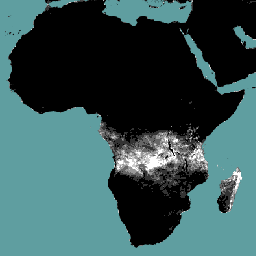
- Dostępność zbioru danych
- 2009-01-01T00:00:00Z–2025-12-11T00:00:00Z
- Dostawca zbioru danych
- FAO UN
- Cykl
- 10 dni
- Tagi
Opis
Składnik danych dotyczący przechwytywania (I) (dekadowy, w mm/dzień) reprezentuje parowanie przechwyconych opadów z pokrywy roślinnej. Intercepcja to proces, w którym opady deszczu są przechwytywane przez liście. Część tych opadów ponownie wyparuje. Wartość każdego piksela reprezentuje średnią dzienną ilość odparowanej wody z intercepcji w danym dekalce.
Pasma
Rozmiar piksela
248,2 metra
Pasma
| Nazwa | Jednostki | Skaluj | Rozmiar piksela | Opis |
|---|---|---|---|---|
L1-I-D |
mm | 0,1 | metry | Intercepcja (dekada) [mm] |
Warunki korzystania z usługi
Warunki usługi
Organizacja Narodów Zjednoczonych do spraw Wyżywienia i Rolnictwa (FAO) ma za zadanie zbierać, analizować, interpretować i rozpowszechniać informacje związane z odżywianiem, żywnością i rolnictwem. W tym celu publikuje szereg baz danych dotyczących tematów związanych z mandatem FAO i zachęca do ich wykorzystywania w celach naukowych i badawczych. Zgodnie z zasadami otwartości i udostępniania przewidzianymi w licencjach na otwarte dane w przypadku baz danych statystycznych oraz zgodnie z mandatem FAO dane z portalu Water Productivity Open Access Portal (WaPOR), który jest częścią AQUASTAT, czyli globalnego systemu informacyjnego FAO dotyczącego wody i rolnictwa, są dostępne bezpłatnie dla społeczności użytkowników.
Cytaty
FAO 2023. Metodologia bazy danych WaPOR: poziom 1. Remote Sensing for Water Productivity Technical Report: Methodology Series. Rzym, FAO. 72 strony.
FAO 2023. Metodologia bazy danych WaPOR V3. Remote Sensing for Water Productivity Technical Report: Methodology Series. Rzym, FAO. https://www.fao.org/3/cc6964en/cc6964en.pdf
Odkrywaj za pomocą Earth Engine
Edytor kodu (JavaScript)
var coll = ee.ImageCollection('FAO/WAPOR/3/L1_I_D'); var image = coll.first(); Map.setCenter(17.5, 20, 3); Map.addLayer(image, {min: 0, max: 50});
